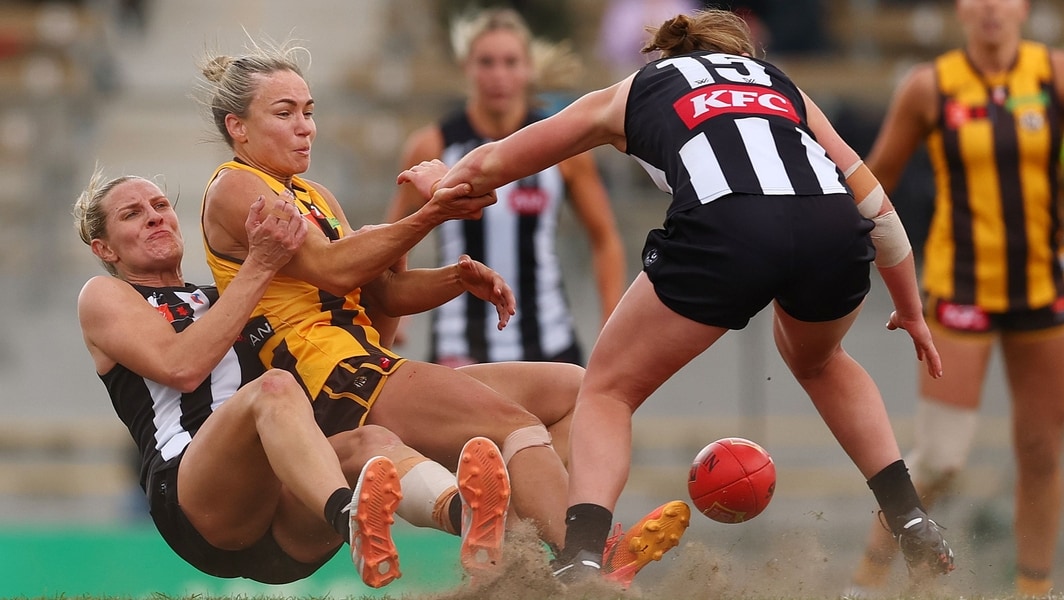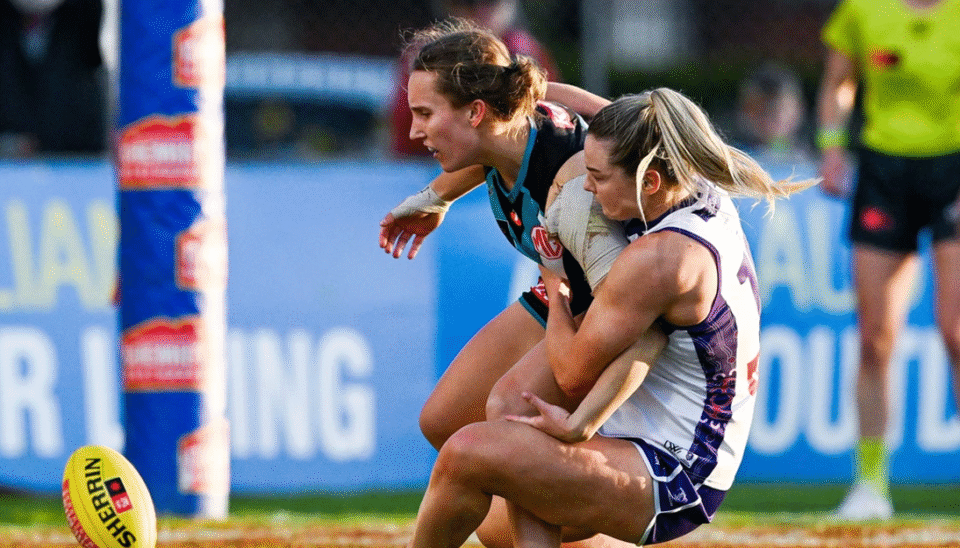DESPITE criticism and external perceptions of a ‘hot whistle’, the AFL is satisfied with the roll-out of the new holding the ball interpretation in the AFLW.
Across the first six rounds of the 2025 season, average free kicks overall have risen by just 1.2 per team per match compared to last year, with holding the ball frees (no genuine attempt) up by 2.4 per match.
Meanwhile, average stoppage numbers have dived significantly, from 67 per game to 44, a decrease of 34 per cent.
With concrete visual examples of the new rules now in hand after six weeks, the AFL sent videos to each club on Wednesday afternoon showing holding the ball decisions from this season. It is hoped the videos will provide greater guidance around what umpires are assessing when deciding whether or not to pay a free kick for holding the ball.
It has been confirmed that two AFLW coaches this season have sought clarity from the AFL around the interpretation of the rule.
A number of coaches including Daniel Webster (Hawthorn), Daniel Lowther (Geelong), Mathew Buck (Carlton) and Ryan Ferguson (Richmond) have commented about the perceived inconsistency of the application of the rule, and their wariness around disincentivising players attacking the ball. It is not suggested any of these coaches have been the ones to seek clarity from the League.
“Overall players have adapted extremely well to the change introduced for season 10, and we’ve seen a significant increase in players trying to move the ball on, which has resulted in more free-flowing football and a reduction in ball-ups per game,” AFLW umpire head coach Annie White said.
“We’re continually working with our umpires to ensure maximum consistency across the group, and we’re pleased with how the umpires have adjudicated the change in interpretation. We note there will be some outliers like with any type of free kick, and we will always provide coaching to individual umpires and the broader group on these examples.

Imogen Barnett tackles Emily Bates during the AFLW Round six match between Collingwood and Hawthorn at Victoria Park, September 20, 2025. Picture: Getty Images
“We welcome discussions with clubs on this and any other matter, and through our standard process we’re in regular communications with them to provide clarity on examples and answer any questions they have.”
Webster has been among the most vocal critics of the new rule interpretation this year, saying the ball winner should be rewarded at all times.
“My biggest thing in my personal view is the rule should be put in place to favour the person winning the ball, not the tackler – so I think the interpretation of the rule goes against the spirit of the game and how it should be paid,” Webster said on The W Show last month.
“In my personal opinion, I think the rules are a gross overreaction to the problem they were trying to solve around clearances, and now we’re having free kicks paid when the ball is out and gone and having to slow the game down and bring the ball back. I think there’s some flow-on effects.”
All-Australian and AFL.com.au pundit Kate McCarthy added she had noticed a trend of players being unwilling to pick up for ball for fear of giving away a free kick.
“People might sit back and say on numbers and on paper we’ve got less stoppages, do we really want our game looking like that where a player doesn’t want to pick up the ball, but there’s less stoppages?,” McCarthy said on The Wrap.
“My opinion? No. I don’t care how many stoppages there are. If a player puts their head over the footy, wins it, and there’s a stoppage as a result, well, that’s footy – that’s what AFL looks like. We can’t have players not wanting to pick up the ball.”
Other key statistics from the first six weeks of the season:
- Average points per team is 41, an increase of four points per team, per game (eight points in total)
- Games decided by five goals or more have decreased by eight per cent, with a greater percentage now sitting in the 2-5 goal bracket of victory margin
- Inside 50s are up by two per team per match, having stayed at a consistent level for the four seasons prior
- The percentage of scores from turnover has risen, and decreased from stoppages
- Ball transition is at its highest ever level, partially on the back of increased skill from lower-ranked teams
- Time in forward half has shifted from 55.5 (winner) – 45.5 (loser), to 53-47, meaning the losing team has had a higher percentage of ball than in years prior
- Teams are averaging three fewer tackles per game compared to 2024



